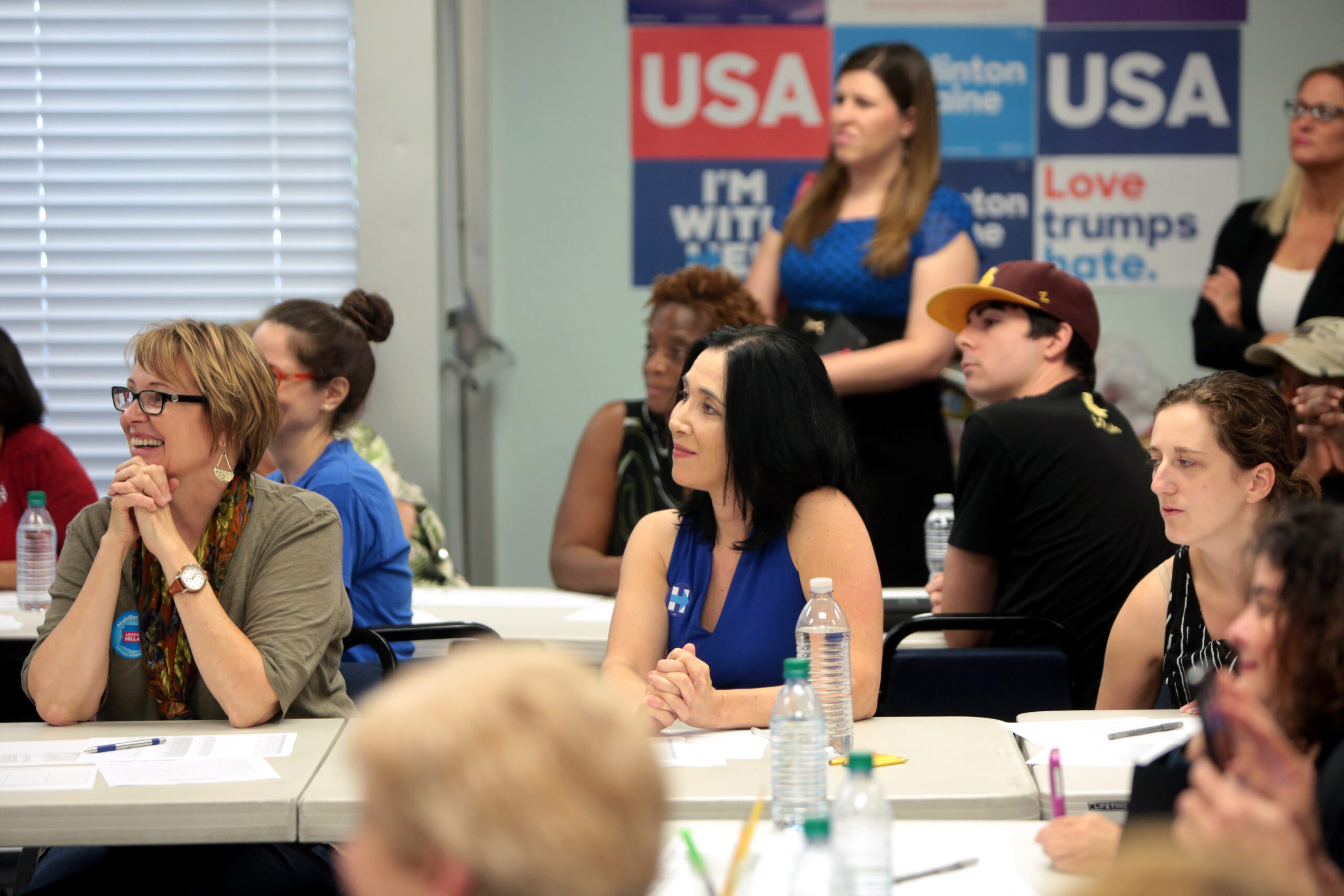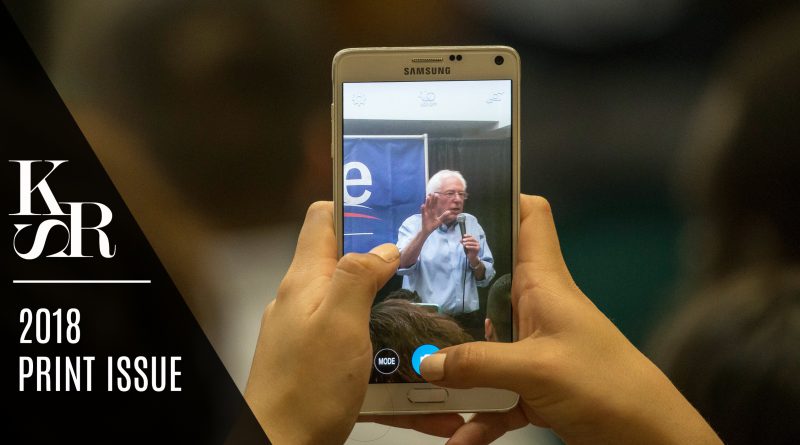BY BEN MCGUIRE
After a bruising 2016 election, a cascade of Democratic victories has given progressive activists reason to hope for future elections, and the use of new mobilization and engagement technologies in those campaigns is getting a lot of attention.
Virginia Republicans barely held their gerrymandered majority after grassroots volunteers across the left powered a decisive Democratic gubernatorial win and seismic shift in the House of Delegates.[1] A groundswell of African American support elected a liberal Democrat to the US Senate in deep-red Alabama over a disgraced, twice-impeached Alabama Supreme Court chief justice. Smiling volunteers stood in the cold November Michigan rain to hand-deliver more than 400,000 signatures that could amend the state’s constitution and move the mapping of congressional districts into a nonpartisan committee.
Digital organizing is one of the key threads running through these stories—progressive volunteers who were engaged and empowered through digital tools that did not exist just two decades ago. In Virginia, organizers sent millions of targeted get-out-the-vote texts and coordinated daily messaging strategy with progressive organizations on Facebook and Twitter.[2] In Alabama, the Democratic National Committee added 1.3 million phone calls and one million text messages to local organizing through online platforms. [3] In Michigan, an all-volunteer nonprofit collecting signatures began as a Facebook group. On their way to a constitutional amendment, they engaged thousands of Michiganders through social media campaigns alongside traditional door knocks and phone calls. Doing so, they spent a fraction of the money that professional organizers or advocacy groups expend on similar efforts.[4]
The story of digital organizing is complex, and barriers remain to integrating technology into traditional organizing. Social scientists and traditional organizers worry that organizing through social media promotes superficial engagement, relies on platforms optimized for advertising, and hurts civic debate.[5] On the other hand, technology promoters promise a massive revolution in digital communication that never quite appears. Rather than merge digital into organizing, the modern political campaign still relegates digital staff to a separate team complete with its own management, processes, culture, and data. If the promise of digital technology in politics is meaningful engagement at massive scale, few if any political movements have reached that potential.
This essay explores the challenges and opportunities in digital organizing. It begins with a brief history of how digital tools have influenced the organizing world, summarizes some of the lessons learned in recent digital campaigns, and argues for an integrated approach that uses the scale and speed of digital tools to scale and augment, not replace, traditional political organizing.
The choice between organizing a campaign through digital tools versus traditional face-to-face methods is a false one.
Since at least 1786, when Philadelphia printers went on strike for a $6 weekly wage,[6] through Abolition, Prohibition, Vietnam, Occupy, and the Women’s March, America has boasted a robust tradition of community organizing. The practice of organizing reached its modern pinnacle in the Civil Rights Movement—a triumph not only of moral leadership but also of logistics, coordination, and tactical effectiveness. A generation of organizers went on to lead myriad fights for justice, collecting lessons about face-to-face engagement and organization building. Through the 20th century, the most effective organizing remained difficult, slow, labor intensive, and costly. In addition, much of its capacity came from civic and labor organizations, which went into decline.
With the rise of cheap, widely available digital communication technologies, many pundits and political professionals predicted that digital tools would transform politics from top-down, message-driven public relations operations to “small d” democratic, citizen-led movements. Despite the 2004 primary loss, the manager of Howard Dean’s famously digital campaign sounded an optimistic note: “Government, the entertainment industry and corporate America better get ready. The American people are going to learn how to organize themselves and then watch out.”[7] In June 2010, a Facebook post calling for action at an annual rally in Cairo quickly became the regime-toppling Tahrir Square protests. Social media tools were changing the relationship between powerful governments and dissidents; overnight, protest organizers could coordinate logistics in ways that “would likely impress even a modern army general with how little effort was needed.”[8] Reflecting on the use of digital tools in President Barack Obama’s 2012 victory, National Field Director Jeremy Bird mused that in future cycles, “We will have difficulty telling a Field Director apart from a Digital Organizing Director. They are one and the same.”[9]
In his 2016 study of how digital tools had changed the world of progressive advocacy, David Karpf suggested that digital tools “can certainly help you mobilize a crowd, but (at least so far) it is less useful for organizing that crowd into a movement or converting that movement energy into long-term victories.”[10] For every Tahrir Square, many more movements like Kony 2012 and Occupy Wall Street grew to massive scale but faded and disappeared before they could build capacity for electoral change. Networked social movements were a mile wide and an inch deep, “capable of responding quickly to breaking news when an issue is likely to generate a strong response from members, but less likely to have strong local chapters capable of pressuring political representatives.”[11] Internet-based movements attracted attention and small commitments (for example, “liking” a post), but they failed to generate what digital movements scholar Zeynep Tufekci calls “network internalities”—the “benefits and collective capabilities attained during the process of forming durable networks.”[12]
It seemed as if there might be an inevitable tradeoff between the scale offered by digital tools and the ability of a movement to build strong and effective relationships. Political campaign management hierarchies reflected this tension. Organizers remained within a dedicated “organizing” silo, and digital teams stayed close to technology, focused more on fundraising than organizing voters. Campaign organizers found themselves repeatedly calling into an ever-shrinking phone list to beg for help, while digital teams sent out repeated emails to large lists without knowing whether there was follow-up on the ground. Potential recruits for volunteer activities were not passed quickly from digital to organizers—most campaigns lacked any dedicated technology or process to transfer data between the units. The vast majority of campaigns “haven’t evolved to think through an integrated ladder of engagement that reflects how people connect with the campaign,” finds Kristee Paschall at the Wellstone Institute. “Instead, we have separate teams in charge of different programs, organizing and mobilizing and contacting with separate lists that sometimes overlap.”[13]
Hypothetically, digital organizing creates an attractive scenario for political campaigns: converting a huge and diffuse base of social media followers into volunteers. Rather than relying completely on volunteers who are older, retired, and already engaged in politics, organizing in digital channels could catalyze a new (and more representative) generation of activists at huge scale and little cost. Rather than attempting to inject outside ideas into a community, social media could be used as a precise listening technology, letting civic leaders and organizers pinpoint sentiment and take advantage of organic energy. To understand how this plays out in practice, it is helpful to compare digital campaigns during the 2016 cycle. Secretary Clinton’s digital team saw new tools as ways to strengthen and grow the reach of a face-to-face organizing model by providing traditional organizers with digital tools to scale outreach. In contrast, Senator Bernie Sanders’s insurgent primary campaign used digital as a tool to utilize massive grassroots enthusiasm, creating independent, distributed teams of volunteers organized online. Both models generated widespread engagement with volunteers; both models have powerful lessons to teach for future cycles.
In the Clinton campaign, organizers used digital tools to 
To organize thousands of local watch parties that tuned in to live video calls with Bernie Sanders, the senator’s team used digital tools, which let them connect with this large-scale excitement quickly. Leadership wanted to replicate Obama’s 2008 primary approach of local volunteer teams led by organizers. But because the campaign did not have a large staff of organizers to manage volunteers, they had to let groups of citizens self-organize into independent teams. To build a team, digital organizing cold-emailed hundreds of people who had expressed interest through digital sources and set up a conference call with 10–50 prospective members. They then invited a subset who completed a simple task to a shared communication channel and gave them responsibility to organize voters. In this way, the Sanders campaign engaged thousands of distributed volunteers into independent teams and put together an imposing volunteer infrastructure on a shoestring budget.[15]
Although the two campaigns thought about and used digital tools very differently, both approaches reveal that we still have a lot to learn about cultivating leaders and supporting communities through digital media. They also show that future campaigns must stop artificially separating digital from organizing; the choice between organizing a campaign through digital tools versus traditional face-to-face methods is a false one. Despite growing sophistication of social media tools, trying to turn millions of low-effort digital engagements into functional and useful volunteers is unrealistic. The problem is not that we don’t yet have the right tools. It’s that campaigns have not been able to turn digital engagements into meaningful interactions at real scale. And despite technological advances, face-to-face conversation between human beings remains the most effective way to achieve mobilization and persuasion. Rather than undermine or replace relationships, advances in digital tools create opportunities to identify and recruit volunteers faster and at greater scale. This lets organizers spend more time creating authentic connections and driving value and less time cold-calling previous volunteers to beg for support.
What are the practical elements of an integrated approach? First, be prepared to take advantage of digital moments. When lots of people are looking at and talking about your campaign, have mechanisms in place to collect email addresses, phone numbers, social media handles, and voter-registration status. This tactic applies not only to the website and social media set-up that serves as the campaign’s public face—it also means making sure that volunteers always have the means to collect critical data from citizens engaged through digital channels. The original Women’s March had stellar success in mobilizing people across the world to show up and be heard, but little campaign infrastructure was prepared onsite to collect voter data and ensure that the digital moment could be converted into on-the-ground volunteers moving forward. In Beto O’Rourke’s Texas campaign for US Senate, organizing staff redirect digital engagements to join local house parties for video town halls. Staff or volunteers are ready on-site to collect contact information and make “hard asks” for people to volunteer in person the next weekend. Through a simple and intuitive process, the campaign is engaging a huge and growing network, long before most campaigns would ever attempt such a large organizing footprint.
An integrated approach to digital and traditional organizing could reinvigorate the world of campaigning by offering massive scale, bringing disengaged voters back into the debate, and creating more spaces for meaningful conversation and leadership development.
Second, build a digital-to-volunteering funnel that prioritizes incremental gains against a large digital base rather than expecting or attempting mass conversion. The sheer size of populations engaged through social media leads some digital advocates to suggest that we should be creating huge revolutionary change by mobilizing everyone we engage. However, no campaign will ever be able to get the thousands or millions of people who express interest in their candidate to show up and phone bank. Instead, identify and recruit volunteers through digital channels to win your organizers a bigger pool for one-on-one conversations and real training. Increasing the percentage of social media engagers who show up to an office by just a few percentage points might represent thousands of new potential volunteers. In Virginia’s gubernatorial election, organizers used new SMS tools to mass-text Democratic registrants for get-out-the-vote volunteering shifts. By scaling and streamlining initial outreach, they created more time for training and direct conversations between organizers and volunteers. On the back end, this generated more shifts and more contact with voters, more efficiently using staff time for the tasks where great organizers can make a difference.
Finally, hire and manage staff to reflect the integration of digital and face-to-face relationships in the real lives of today’s voters. Don’t build one organizing team that does only traditional field work and another separate team of “digital organizers” who engage people online. You’ll prevent the former from the kind of scale that can make them cost effective and prevent the latter from creating meaningful and useful contributions to voter contact goals.
Digital is simply another tool that we can use in organizing work; as Zack Exley, a veteran of multiple digital and organizing campaigns (including Sanders 2016) argues, it makes no more sense to hire “traditional” and “digital” organizers separately than it would to hire “phone” and “non-phone” organizers.[16] Clinton’s Iowa primary team broke from tradition when they pushed organizers to communicate directly with voters through social media and publicly push campaign messages through Facebook and Twitter. Driving staffers to cultivate a digital presence in addition to a traditional “ground game” let them communicate with and activate more young voters, broadcast messages beyond early volunteers, and publicly demonstrate the campaign’s size and strength.[17]
Moving digital organizing entirely under organizing would drive coordination and data-sharing but carries risks; if digital does not have a seat at the table, important early investments in technology (which take a long time to pay off) could be missed. On the other hand, keeping digital organizing under a technology or digital chief ensures a close relationship with tech and analytics but could prevent an effective working relationship with organizers. More important than any specific structure is that organizers (and their managers) have a coherent plan to use digital tools and that those tools reflect actual needs and experiences of organizers in the field.
The experience of organizers in recent campaigns shows that an integrated approach to digital and traditional organizing could reinvigorate the world of campaigning by offering massive scale, bringing disengaged voters back into the debate, and creating more spaces for meaningful conversation and leadership development. As organizers move on from Virginia and Alabama and begin to prepare for the 2018 elections, successful digital approaches will follow them and build in scale and effectiveness. If progressive organizations can learn to harness that energy to organize Americans into a coherent and positive political voice, the potential impacts could be revolutionary.
Ben McGuire is a first-year master in public policy student at the John F. Kennedy School of Government at Harvard University. He has a professional background in campaign field organizing and analytics for field, digital, and early voting. Before coming to Harvard, Ben also served as a research consultant to higher education and K–12 leaders on cybersecurity, data analytics, and optimizing the use of academic resources.
Photos:
Attendee snaps a photo of Bernie Sanders at a campaign event in Des Moines, Iowa / Credit: Phil Roeder from Flickr
Women for Hillary volunteers attend a phone banking event at the Arizona Democratic Party headquarters in Phoenix, Arizona / Credit: Gage Skidmore from Flickr
[1] “Organizing Still Matters: What We Saw in Virginia in 2017,” NGP VAN, last modified 9 November 2017, accessed 7 January 2018, https://blog.ngpvan.com/engineering/va-17.
[2] Eric Bradner, “Democrats see a digital breakthrough in Virginia wins,” CNN, 10 November 2017, http://www.cnn.com/2017/11/10/politics/democratic-groups-virginia-digital-breakthrough/index.html.
[3] Gabriel Debenedetti, “DNC waged stealth organizing campaign for Jones,” Politico, 12 December 2017, https://www.politico.com/story/2017/12/12/alabama-senate-democrats-jones-293496.
[4] “It’s time we draw the line,” Voters Not Politicians, last modified 2017, accessed 7 January 2018, http://www.votersnotpoliticians.com/; Sam Levine, “Michigan Gerrymandering Reform Hits A Major Milestone,” Huffington Post, 18 December 2017, https://www.huffingtonpost.com/entry/michigan-gerrymandering-reform_us_5a37ee8ce4b040881becd450.
[5] For example, see: Zeynep Tufekci, Twitter and Tear Gas: The Power and Fragility of Networked Protest (New Haven: Yale University Press, 2017); Catherine Steiner-Adair and Teresa H. Barker, The Big Disconnect: Protecting Childhood and Family Relationships in the Digital Age (New York: Harper Collins, 2013).
[6] Henry P. Rosemont, American Labor’s First Strike: Articles on Benjamin Franklin, The 1786 Philadelphia Journeymen’s Strike, Early Printers Unions in the U.S., & Their Legacy (New York, Charles H. Kerr, 2007).
[7] Joe Trippi, The Revolution Will Not Be Televised: Democracy, the Internet, and the Overthrow of Everything (New York, Harper Collins, 2004), 57.
[8] Tufekci, Twitter and Tear Gas, 60.
[9] Patrick Ruffini, “Going Inside the Cave,” Engage Strategies, last updated January 2013, accessed 27 January 2018, https://enga.ge/going-inside-the-cave/.
[10] David Karpf, Analytic Activism: Digital Listening and the New Political Strategy (Oxford: Oxford University Press, 2016), Kindle.
[11] Micah L. Sifry, The Big Disconnect: Why the Internet Hasn’t Transformed Politics (yet) (New York: OR Books, 2014), Kindle.
[12] Tufekci, Twitter and Tear Gas, 75.
[13] Kristee Paschall, interview by author, 14 December 2017.
[14] Jessica Morales Rocketto, “Invest in Digital Organizing,” Medium, 8 November 2017, accessed 7 January 2018, https://medium.com/hillary-for-america-digital-one-year-later/invest-in-digital-organizing-8060696c6275.
[15] Becky Bond and Zack Exley, Rules for Revolutionaries: How Big Organizing Can Change Everything (White River Junction, VT: Chelsea Green Publishing, 2016), Kindle.
[16] Zack Exley, interview by author, 5 January 2018.
[17] Pat Rynard, “The Clinton Campaign’s Digital Organizing Strategy and the Future of Campaigns,” Iowa Starting Line, 4 May 2015, https://iowastartingline.com/2015/05/04/the-clinton-campaigns-digital-organizing-strategy-and-the-future-of-campaigns/.

